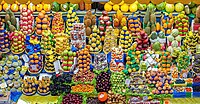
Photo from wikipedia
BACKGROUND While both maturity and light exposure are important factors determining olive fruit physiology, the relationship between maturity, canopy position and optimal harvesting time has not been well-studied. To understand… Click to show full abstract
BACKGROUND While both maturity and light exposure are important factors determining olive fruit physiology, the relationship between maturity, canopy position and optimal harvesting time has not been well-studied. To understand the interaction of these factors, olive fruits from upper and lower layers of the canopy were harvested from September to January. Maturity, moisture and fat content of the fruit as well as the quality and minor components of the oil extracted were measured. RESULTS Lower light interception at the lower canopy positions resulted in differences in the fruits and oil extracted between canopy layers. Upper layer presented 60% of the overall production; fruit had one unit more of maturity index, 3% less moisture and 5% more fat content. Oil extracted from the upper layers presented higher concentration of oleuropein and ligstroside aglycone. Fruits from upper layers at maturity index of two had higher fat content and more total phenols in the oil extracted when compared with fruits from lower layer with the same maturity index. CONCLUSIONS Differences in oil composition between layers do not correlate with differences in the fruit maturity index; instead, fruit position is a determining factor for physiological processes related to fruit growth and oil composition. © 2019 Society of Chemical Industry.
Journal Title: Journal of the science of food and agriculture
Year Published: 2019
Link to full text (if available)
Share on Social Media: Sign Up to like & get
recommendations!